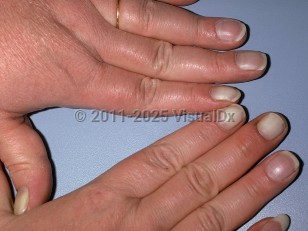- True leukonychia is characterized by abnormal nail matrix keratinization causing nail plate parakeratosis.
- Apparent leukonychia is characterized by a white appearance of the nail due to abnormal vasculature of the nail bed.
- Pseudoleukonychia is white nail caused by exogenous factors.
When acquired, true leukonychia usually appears as one or more transverse white bands running parallel to the distal margin of the lunulae (also called Mees' lines). These lines are often located at the same level on each nail and will move distally and then disappear as the nail grows out. The pathogenesis is thought to be a disruption of nail plate keratinization secondary to systemic stress. This pattern was originally described with arsenic poisoning but has subsequently been associated with chemotherapy, systemic infections (measles, tuberculosis), renal failure, heart failure, and systemic lupus erythematosus. Total leukonychia has been reported in human immunodeficiency virus (HIV)-infected patients. True leukonychia is also seen in patients with Darier disease and Hailey-Hailey disease.
Punctate leukonychia is a pattern of true leukonychia that is usually seen in children and is secondary to trauma. Small white marks grow out with the nail. It can be seen in adults with trauma from manicuring. Apparent leukonychia (Terry nails, half-and-half nails, Muehrcke lines) is often seen with chronic renal failure, nephrotic syndrome, cirrhosis, congestive heart failure, and adult-onset diabetes. Nail bed pallor may be due to anemia, edema, or vascular impairment.



 Patient Information for
Patient Information for 
